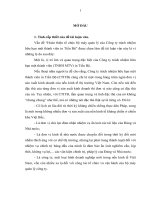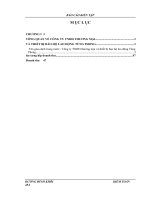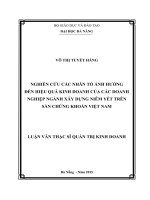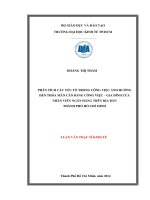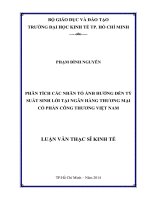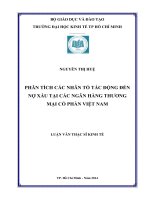(Luận văn thạc sĩ) factors influencing customer intention to purchase automobile in hanoi
Bạn đang xem bản rút gọn của tài liệu. Xem và tải ngay bản đầy đủ của tài liệu tại đây (1.52 MB, 122 trang )
ĐẠI HỌC QUỐC GIA HÀ NỘI
KHOA QUẢN TRỊ VÀ KINH DOANH
---------------------
ĐINH HOÀNG AN
FACTORS INFLUENCING CUSTOMER INTENTION
TO PURCHASE AUTOMOBILE IN HANOI
CÁC NHÂN TỐ ẢNH HƯỞNG ĐẾN Ý ĐỊNH
MUA Ô TÔ CỦA KHÁCH HÀNG TẠI HÀ NỘI
LUẬN VĂN THẠC SĨ QUẢN TRỊ KINH DOANH
HÀ NỘI - 2019
ĐẠI HỌC QUỐC GIA HÀ NỘI
KHOA QUẢN TRỊ VÀ KINH DOANH
---------------------
ĐINH HOÀNG AN
FACTORS INFLUENCING CUSTOMER INTENTION
TO PURCHASE AUTOMOBILE IN HANOI
CÁC NHÂN TỐ ẢNH HƯỞNG ĐẾN Ý ĐỊNH
MUA Ô TÔ CỦA KHÁCH HÀNG TẠI HÀ NỘI
Chuyên ngành: Quản trị kinh doanh
Mã số: 60 34 01 02
LUẬN VĂN THẠC SĨ QUẢN TRỊ KINH DOANH
NGƯỜI HƯỚNG DẪN KHOA HỌC: PGS.TS. LÊ ANH TUẤN
HÀ NỘI - 2019
DECLARATION
The author confirms that the research outcomes in the thesis is the result of
author‘ independent work during study and research period and it is not yet
published in other‘s research and article.
The other‘s research result and documentation (extraction, table, figure,
formula and other document) used in the thesis are cited properly and the
permission (if required) is given.
The author is responsible in front of the Thesis Assessment Committee,
Hanoi School of Business and Management, and the laws for above-mentioned
declaration.
TABLE OF CONTENTS
LIST OF TABLES .......................................................................................................i
LIST OF FIGURES................................................................................................... iii
CHAPTER 1 INTRODUCTION ................................................................................ 1
1.1. Rationale of the research .................................................................................. 1
1.2. Research objectives .......................................................................................... 5
1.3. Research object ................................................................................................. 5
1.4. Scope of the study ............................................................................................. 5
1.5. Significance of the study .................................................................................. 6
1.6. Structure of the research ................................................................................... 6
CHAPTER 2 LITERATURE REVIEW ..................................................................... 8
2.1. Definitions of Terms ......................................................................................... 8
2.1.1. Definition of customer purchasing intention .............................................. 8
2.1.2. Definition of customer purchasing intention process ................................. 9
2.2. Customer intention to purchase auto .............................................................. 18
2.3. Conceptual research model and research hypotheses ..................................... 18
2.3.1. Related literatures ..................................................................................... 18
2.3.2. Factors influencing on customer purchasing intention in automobile ..... 20
2.3.3. Research model ........................................................................................ 23
CHAPTER 3 RESEARCH METHODOLOGY ....................................................... 24
3.1. Research philosophy ....................................................................................... 24
3.2. Research approach .......................................................................................... 26
3.3. Research strategy ............................................................................................ 29
3.4. Research method ............................................................................................. 30
3.5. Data collection ................................................................................................ 31
3.5.1. Primary data ............................................................................................. 31
3.5.2. Secondary data ......................................................................................... 31
3.6. Survey of questionnaire .................................................................................. 31
3.6.1. Design of the survey ................................................................................. 31
3.6.2. Sample size ............................................................................................... 33
3.6.3. Pilot test .................................................................................................... 33
3.7. Data analysis techniques ................................................................................. 33
CHAPTER 4: EVALUATION OF CUSTOMER INTENTION TO PURCHASE
AUTOMOBILE IN HANOI ..................................................................................... 38
4.1. Demographic description ................................................................................ 38
4.2. Descriptive statistics analysis ......................................................................... 40
4.3. Reliability test ................................................................................................. 43
4.4. Explanatory factor analysis for independent variables ................................... 48
4.5. Explanatory factor analysis for dependent variables ...................................... 51
4.6. ANOVA analysis ............................................................................................ 52
4.6. Multiple linear regression ............................................................................... 56
CHAPTER 5: RECOMMENDATIONS TO VIETNAMESE AUTOMOBILE
ENTERPRISES ......................................................................................................... 64
5.1. Conclusion ...................................................................................................... 64
5.2. Recommendation ............................................................................................ 64
REFERENCE ............................................................................................................ 67
LIST OF TABLES
Table 1.1: Vehicle sales in the ASEAN region by market, 2013-16 ..........................4
Table 3.1: Survey of Questionnaire‘s Items..............................................................31
Table 3.2: Summary of data analysis techniques ......................................................35
Table 4.1: Mean value analysis .................................................................................41
Table 4.2: Reliability level of consumer purchasing intention .................................44
Table 4.3: Reliability level of brand awareness ........................................................45
Table 4.4: Reliability level of perceived value .........................................................46
Table 4.5: Reliability level of brand personality.......................................................47
Table 4.6: Reliability level of product quality ..........................................................48
Table 4.7: KMO and Bartlett‘s Test for independent variables ................................49
Table 4.8: Total Variance Explained Table for independent variables ....................49
Table 4.9: Rotated Component Matrix for independent variables ............................50
Table 4.10: KMO and Bartlett‘s Test for dependent variables .................................51
Table 4.11: Total Variance Explained Table for dependent variables ......................51
Table 4.12: Rotated Component Matrix for dependent variables .............................52
Table 4.13: Independent Sample T-Test for Gender.................................................52
Table 4.14: On-Way ANOVA for Age .....................................................................53
Table 4.15: On-Way ANOVA for Age with Tukey B test .......................................54
Table 4.16: On-Way ANOVA for Income per annum..............................................54
Table 4.17: On-Way ANOVA for Income per annum with Tukey B test ................55
Table 4.18: On-Way ANOVA for Occupation .........................................................55
Table 4.19: On-Way ANOVA for Occupation with Tukey B test ...........................56
Table 4.20: Multiple linear regression ......................................................................57
Table 4.21: Multiple linear regression between customer purchasing intention and
items of brand awareness ..........................................................................................58
Table 4.22: Multiple linear regression between customer purchasing intention and
items of perceived value............................................................................................60
i
Table 4.23: Multiple linear regression between customer purchasing intention and
items of brand personality .........................................................................................61
Table 4.24: Multiple linear regression between customer purchasing intention and
items of product quality ............................................................................................62
ii
LIST OF FIGURES
Figure 1.1: GDP growth rate of countries in Southeast Asia ......................................1
Figure 1.2: How do Vietnamese consumers spend their spare cash? .........................3
Figure 2.1: Customer purchasing intention process ....................................................9
Figure 2.2: Brand equity model ................................................................................14
Figure 2.3: Research model.......................................................................................23
Figure 3.1: Research onion .......................................................................................24
Figure3.2: Research process......................................................................................28
Figure 4.1: Gender summary.....................................................................................38
Figure 4.2: Age summary ..........................................................................................39
Figure 4.3: Income per annum summary ..................................................................39
Figure 4.4: Occupation summary ..............................................................................40
iii
CHAPTER 1 INTRODUCTION
1.1. Rationale of the research
Vietnam is successful story in term of economic renovation since the
government conducts economic transformation from state-owned management to
market-oriented management (Pincus, 2015). The country gains significant result in
term of economic development and better living standards for local people (The
World Bank Group, 2016). In term of economic development, Vietnam obtains
significant results in GDP growth rate. According to Asian Development Bank
(2018), GDP growth rate of the country during 2015, 2016, and 2017 are 6.7%,
6.2%, and 6.8% respectively and it is forecasted up to 7.1% and 6.8% in 2018 and
2019. Asian Development Bank (2018) also estimates that GDP growth rate of
Vietnam is highest compared to GDP growth rate of other countries in Southeast
Asia in 2018.
Brunei
Singapore
1.5%
3.1%
Thailand
4.0%
Malaysia
5.3%
Indonesia
5.3%
Philippines
6.8%
Myanmar
6.8%
Laos
6.8%
Cambodia
7.0%
Vietnam
7.1%
Figure 1.1: GDP growth rate of countries in Southeast Asia
Source: Asian Development Bank (2018)
The context of Vietnamese people have better living standards is proven
through the fact that Vietnam has high GDP per capita growth rate. Asian
Development Bank (2018) reports the growth rate of Vietnamese GDP per capita is
improved from 5.1% in 2016 to 5.8% in 2017. It is forecasted that GDP per capita
1
growth rate is 6.1% in 2018 (Asian Development Bank, 2018). Vietnam is also
ranked at second position in term of highest GDP per capita growth rate and the
country is only after Cambodia with GDP per capita growth rate of 6.6% in 2018
(Asian Development Bank, 2018). Vietnam also has stable politics with political
stability index is improving over the years (The Global Economy, 2018). It is
worthwhile to capture a trend of which more and more Vietnamese people are
moving from rural to urban area. The World Bank (2018) reports that urbanization
rate of Vietnam is 34.2% in 2016 compared to 28.5% in last 10 years ago.
Moreover, disposal income of Vietnamese people is being increased over last few
years and it is determined as key motivation for the change of consumer behavior
(Nielsen, 2018). People in Vietnam have high consumer confidence index and the
country is being ranked in top 10 countries in the global ranking provided by The
Conference Board (2018).
Moreover, based on the speed of social development, the demand of
travelling and relaxing after hard-working is increasing to reduce stress and pressure
people get every day in their busy lives (Wang 2001, Terry 2010). The ―tourism‖
phenomenon is perceived in the human life as a necessity which is ―created‖ by
man, ―for‖ man and ―with‖ man. Definitely, tourism can be seen as a way that
―man‖ serves ―man‖ to relax and enjoy the life based on supports from natural
conditions (Nakajima 2003, Cheia 2013). Thus, benefits of tourism include not only
understanding and researching new destinations‘ cultures and customs such as
different places‘ mystery, history and habits, but also recovering health and
improving the human labor productivity (Roxana 2012, Chen 2013).
Vietnamese people have preference towards non-food products and they
spend their spare cash to holiday and vacations, new clothes, new technology
products, home improvements, out of home entertainment, and medical and
insurance services. Among various consumption purposes for spending spare cash,
the study drives its interest towards holiday and vacation since the consumption rate
of this category is about 44% and it is only lower than the consumption rate of new
clothes which is about 49% (Nielsen, 2018).
2
Figure 1.2: How do Vietnamese consumers spend their spare cash?
Source: Nielsen (2018)
The automobile industry in Vietnam is relatively in early stage of
development. Before 1992, most of vehicles belonged to the government and they
were mainly imported from Soviet Union or the group of socialist states of Central
and Eastern Europe. In addition, it is notable that Vietnam conducts economic
renovation in 1986 aiming at stimulating and liberalizing the economy. Such
economic reformulation created opportunities to develop automobile industry by
granting auto assembly licenses to more than 30 regional assemblers
(PricewaterhouseCoopers – PwC, 2007). It was the first time when global
automotive manufacturers such as Mitsubishi, Toyota, and Isuzu started their
business and operational chains in Vietnam during 1995. Yozi (2013) emphasizes
that production and sales of automobiles in ASEAN‘s nations have been upward
recently. Pugliese (2017) provides statistics about vehicle sales in ASEAN region
from 2013 to 2016.
3
Table 1.1: Vehicle sales in the ASEAN region by market, 2013-16
Country
2013
2014
2015
2016
%
change
Indonesia
1,229,901 1,208,019 1,013,300 1,060,000
-4.6
Thailand
1,325,079
881,832
799,592
768,788
-3.9
Malaysia
655,793
666,465
666,674
580,124
-13
Philippines
212,682
270,372
346,865
452,751
30.5
Vietnam
96,692
133,588
208,568
271,833
30.3
Singapore
27,374
42,980
74,544
106,684
43.1
3,547,521 3,203,256 3,109,543 3,240,180
4.2
Total
Source: Pugliese (2017)
Table 1 shows that Vietnam gains high percentage of change during 20132016 (30.3%) and it is only after two countries as Philippines (30.5%) and
Singapore (43.1%). However, number of vehicle sales in Vietnam is much lower
than in the other countries. During 2016, there are 271,833 vehicles sold in Vietnam
while these number in Indonesia, Thailand, and Malaysia are more than double.
Moreover, Table 1 indicates that Vietnam gains high potential development in
automobile market with strong annual growth rate while other markets like
Indonesia and Thailand see a decline in their yearly vehicle sales. In this context,
the competition in Vietnam‘s automobile industry is very high and automobile
manufacturers need to have clear business strategy to cope up with threats and to
take advantage of opportunities from the market as well as to rely on major
strengths to overcome major weaknesses.
In Vietnam, there are some studies that are developed by local researchers to
detect customer purchasing intention towards automobile product. For example,
Mai & Ngo (2017) measure the effect of event sponsorship on customers‘ brand
awareness and purchase intention in Vietnamese automobile market. Quantitative
research method is applied and it is identified that the sponsored event and event
involvement have both direct and indirect influence on customer purchasing
intention but the impacts are generally very low. Bui (2015) utilises qualitative
4
research method to evaluate about innovative vehicle in Vietnam. However, this
study is based on secondary data and it lacks of empirical measurement about how
customer purchasing intention is influenced by which factors and what the level of
the impacts are. In this context, this study is developed with strong focus on both
weaknesses in previous studies of local researchers: one is to identify the factors
that have high overall explanation to changes of customer purchasing intention in
Vietnamese automobile market and second is to identify how the level of impacts of
chosen factors are.
1.2. Research objectives
This study is developed with following research objectives:
To get in-depth understand about customer purchasing intention and
customer purchasing process.
To examine factors influencing customer intention to purchase
automobile in previous studies.
To measure the influences of factors on customer intention to
purchase automobile in Hanoi, Vietnam.
To provide recommendations for automobile dealers to strengthen their
sales.
1.3. Research object
Research object refers to customers who want to purchase automobile in
Hanoi, Vietnam.
1.4. Scope of the study
Content: This research focuses on customer intention to purchase automobile
in Hanoi, a capital of Vietnam. By determining the factors and measuring the
influences of factors on customer intention to purchase auto, the study will help
other researchers and business practitioners in automobile industry in Vietnam to
provide certain marketing programs to foster sale revenues and volume respectively.
Location: This research is carried out in Hanoi, Vietnam. The survey of
questionnaire is developed and then it is delivered to the customers who have been
intention to purchase automobile in three automobile dealers of Toyota, Honda, and
5
General Motors.
1.5. Significance of the study
This study will identify what the level of customer purchasing intention
towards automobile products in Vietnam and it helps the auto dealers in Vietnam to
understand their customer preference and then they can decide which appropriate
marketing strategies to leverage the customers‘ demands especially when Vietnam auto
market is optimistic with a lot of demand from local citizen for purchasing auto products
for both personal and business purposes. This study is also significant to other
researchers since they can find a good summary about previous studies about customer
purchasing intention towards auto products as well as good key finding for Vietnam
market.
1.6. Structure of the research
This study is conducted with five chapters.
Chapter 1 Introduction
The main part of this chapter is to provide rationale of choosing researched
topic as well as proposing research objectives. This chapter provides research
object, scope of the study, and what the benefits of the readers could get.
Chapter 2 Literature Review
This chapter provides the definitions of customer purchasing intention and its
process. This chapter also consists of part about the definition of customer
purchasing intention towards auto products. Previous empirical evidences are
sought and the relationship between customer purchasing intention and some factors
is discussed before going to the final research model with research hypotheses.
Chapter 3 Research Methodology
This chapter discusses about research onion process and it begins with the
choice of research philosophy, research approach, research strategy, and research
method. This chapter proposes how primary and secondary data to be collected.
Regarding to primary data, a survey of questionnaire is developed and sample size
is proposed accordingly. Moreover, some data analysis techniques that will be used
in later chapter will be proposed in this chapter.
6
Chapter 4 Evaluation of Customer Purchasing Intention to Purchase
Automobile in Hanoi
This chapter provides respective evaluation about customer purchasing
intention to purchase auto products in Hanoi. Herein, some data analysis techniques
that are proposed in Chapter 3 will be conducted based on primary data. Key
findings from descriptive statistics are discussed and then it comes up with
evaluation of data reliability and validity. ANOVA analysis helps the researcher to
detect the differences among different demographic characteristics groups and
multiple linear regression will reveal causal relationship among variables.
Chapter 5 Recommendations to Vietnamese Auto Mobile Enterprises
This chapter provides recommendations to Vietnamese automobile enterprises in
Hanoi and Vietnam and what the marketing campaign and key operational are highlights
to help them further increasing the customer demand and purchasing auto products.
7
CHAPTER 2 LITERATURE REVIEW
2.1. Definitions of Terms
2.1.1. Definition of customer purchasing intention
The concept of consumer behavior has gained much attention from previous
researchers (Nguyen, 2015). During the time, the concept of consumer behavior is
developed by different researchers and no common concept is provided but new
concept is then supplemented to older ones (Bray, 2008). Early definition of
consumer behavior is provided by Walter (1974) and this researcher defines
consumer behavior as the process whereby individual consumers decide what to
buy, when to buy, how to buy, and whom to buy of products and services. Later,
Mowen (1993) provides another definition for consumer behavior whether the
consumers conduct action related to acquiring, consuming, and disposing of goods
and services as well as feedback during the time of utilization. Schiffman & Kanuk
(1997) define consumer behavior as reactions of the consumers and it is reflected
through actions of searching for products and services that are relevant to their
needs, purchasing the most relevant ones, using purchased products and services
before disposing them. Moreover, Schiffman & Kanuk (1997) also categorize
consumer into personal and organizational and while personal consumers purchase
products and services for final consumption, organizational consumers purchase
products and services for their businesses and operations. According to Solomon
(2009), consumer behavior is defined as a process which involves selection, buying,
using, and disposing products of customers based on their needs and demands.
Other researchers like Hoyer et al. (2013) provide similar definition for consumer
behavior as totality of customers‘ decision towards product acquisition,
consumption, and disposition. In this study, consumer behavior is defined as the
process of which it is composition of consumers‘ actions and psychologies in term
of information process, purchasing, utilizing, and disposing products.
Customer purchasing intention is a process from the search of, the
purchasing of, the utilization of, and the feedback given on products and services‘
8
performance (Enis, 1974). Kotler (2000) also provides the concept of consumer
behaviour and it belongs to marketing perspective. It means consumer behaviour is
a process which includes the combination of actions and assessment of products and
services (Kotler, 2000). Recently, Kumar (2010) defines consumer behaviour as the
attitudes and the actions of the consumers given to specific products and services
offered by the companies in comparison with other products and services in the
market.
2.1.2. Definition of customer purchasing intention process
In this study, the definition of customer purchasing intention process is
proposed by Riley (2012). This process is illustrated in the figure below:
Needs and
problem
perception
Searching
for
information
Alternative
option
evaluation
Purchasing
desire
products
and services
After
purchasing
evaluation
Figure 2.1: Customer purchasing intention process
Source: Riley (2012)
The first step in customer purchasing intention process is to identify how the
customers perceive about their needs and their problems. According to Kotler &
Armstrong (2010), the customers only purchase a product or service when they
suffer a urgent needs or problems that foster them to purchase target things to fulfill
the needs or to overcome the problems. The second step refers to the action of the
customers to search for relevant information of target products or services (Riley,
2012). In general, the customers often look up specific characteristics of key
functions of products or services and to evaluate how they can address their needs
or their problems or not (Kotler & Armstrong, 2010). The third step in customer
purchasing intention process is the action of evaluating alternative options, meaning
that the customers will find alternative products or services and they will evaluate or
compare specific characteristics or functions of a product or service with others
(Riley, 2012). The objective of the customers in this step is to identify which
product or service is more ultimate or more superior compared to others (Wright,
9
2006). The fourth step is the action of purchasing product or service from the
customers and the customers will select the products or services that are most
relevant to their needs and demands (Kotler & Armstrong, 2010). Finally, the last
step is to make evaluation after purchasing products or services from the customers.
Khan (2006) indicates that the customers often provide their self-assessment after
certain time of using purchased products or services. The evaluation is either
positive or negative depended on how purchased products or services can satisfy or
dissatisfy their needs and their problems (Kardes et al., 2011).
2.1.3. Brand
Brand is existing for many years but its definitions are formulated like a
trademark of particular products and services since late of 19th century (Fullerton,
1988; McCrum, 2000; Moore and Reid, 2008). According to Feldwick (1991),
brand is generally perceived as a guarantee of authenticity. One of common
definition of brand is provided by American Marketing Association (1960) and it is
either a term or a design or a name or a symbol or combined of those which help the
firms to differentiate their products and services with other competitors. It is
denoted that brand is related to intangible aspect of products and services (Gardner
and Levy, 1955; Wood, 2000). Recently, American Marketing Association (1995)
updates the definition of brand and it refers to any features of products and services
that help the firms to differentiate themselves with others.
Product and brand is different concept and the differences between them are
highlighted by Gunelius (2018). The first difference is recognized as product is
produced by the firms and it is sold to the customers in exchange for money while
brand is established to increase customer perception towards product of the firms
and it helps to improve customer expectation and customer experience. Another
difference between product and brand is that product can be copied by other
competitors and it can be replaced by new products but brand is unique and it
cannot be copied or replaced by others (Gunelius, 2018). The difference between
product and brand is reflected through its definition. Kotler et al. (2003) define
product as everything which is shown in the market and the customers purchase
10
product to facilitate for their needs. Keller (1998) define brand as a set of mental
association and it reflects how the customers perceive about the value of product or
service.
Since brand become important concept in marketing theories and practices, it is
required to explore functions of brand. A numerous studies which are developed to
highlight brand‘ functions such as Hoeffler and Keller (2001) and Yoo et al. (2000).
These studies strongly emphasize that the firms need to establish strong brand as
competitive advantage against other competitors (Keller, 2002). In this section,
brand‘ functions are put into discussion.
The first function of brand refers to its product-related effects. It is asserted
that brand is associated with the customer evaluation towards a product and service and
it also impacts on perceived product or service quality and customer purchasing
intention and purchasing rate (Day and Deutscher, 1982; Rao and Monroe, 1989;
Brown and Dacin, 1997). Moreover, when the customers feel familiarity with brand,
they are likely to purchase products under this brand accordingly (Feinberg et al.,
1992). In addition, this function of brand determines attitudinal loyalty and purchase
loyalty in which attitudinal loyalty from the customers allows the firms to gain the
benefits from greater relative prices of products and services while purchase loyalty
enables the opportunity to acquire higher market share (Chaudhri and Holbrook, 2001).
The second function of brand is determined through its price-related effects.
Empirical evidences show that brand contributes to the larger prices differences
(Simon, 1979; Agrawal, 1996; Sethuraman, 1996). Furthermore, brand allows the
firms to more immune to price increases (Sivakumar and Raj, 1997). On the other
hand, it means that the firms which have good brand management gain are less price
sensitivity and they do not need to go to the price competition with other
competitors which have small brand (Bemmaor and Mouchoux, 1991; Russel and
Kamakura, 1994; Bucklin et al., 1995). Empirical evidence from Boulding et al.
(1994) indicates that when the firms conduct unique advertising messages to their
customers, they avoid future price competition.
The third function of brand is identified as communication-related effects.
11
According to Sawyer (1981), well-known brand or liked brand provide good
communication effects. It is asserted that halo effect is appeared when the firms
bring positive feelings to their customers when an advertising of a brand is
published (Brown and Stayman, 1992). Moreover, the customers give favorable
attitudes to a brand with humor in advertising contexts rather (Stewart and Furse,
1986; Chattopadhyay and Basu, 1990). In the contrast, the customers react
negatively 78to the advertising context with comparative contents (Belch, 1981;
Kamins and Marks, 1991). Furthermore, Raj (1982) obtains empirical evidence of
which the customers who are loyalty with particular brand do have higher
purchasing rate when more advertisings are delivered accordingly. In addition, the
customers who are loyalty with strong brand are more forgivable in case of negative
information from these brand (Ahluwalia et al., 2000).
The last function of brand is channel-related effects. It is denoted that the
firms which have strong brand often have higher acceptance rate when new
products and services are offered to the customers (Montgomery, 1975). In addition,
the products which are belonged to strong brand are often acquired and sold in
distribution channels or stores due to they have high quality of images to the
customers (Lal and Narasimhan, 1996).
The importance of brand in the market economy is reflected through its value
to the firms. According to Denoue and Saykiewicz (2009), brand brings value to the
firms and it is considered as one of the most important resources of the firms.
Empirical evidences affirm the role of brand as a business tool and it helps to
generate profit and to enhance values delivered to the firms (Kapferer, 2005; Rust et
al., 2005). Kapferer (2005) examines the proportion of brand to the value of several
firms and this researcher identifies that brand contributes to at least 52% of value of
examined firms. In addition, the mainstream of literatures about brand confirms that
brand is existed to improve customer value (Aaker, 1996; Keller, 2008; Kotler and
Keller, 2009). It is denoted that the customers today are being involved into brand
creation process or the firms create their brands in line with target customers
(Denoue and Saykiewicz, 2009). The importance of brand in the market economy is
12
finally presented in its roles to national economy. This statement enables the
establishment of nation brand which are explored under 4 perspectives, including
country of origin (Papadoplous and Heslop, 2002), public diplomacy (van Ham,
2001), national identity (Smith, 1991), and place branding (Kotler et al., 2002).
According to Kim (2012), nation brand is considered as government‘s strategic tool
which is conducted in order to shape nation‘s cultural policy.
According to Touminen (1999), the concept of brand equity is emerged since
early 1990s and it is generally perceived as brand values with the integration of
technologies, trademarks, and other intangibles. It is asserted that different
researchers provide different definitions for brand equity. Aaker (1991) defines
brand equity as the inclusion of asset and liabilities associated with a brand and it is
often reflected through name and symbol that add or subtract to the value of product
and service to the firms or to the customers. Barwise (1993) defines brand equity as
a differentiated and clear image of a firm as addition to the characteristics of
products and services. Keegan et al. (1995) provide another definition for brand
equity as the incremental price that the customers pay for products and services of
one company in comparison with similar products and services from other
competitors. In addition, Keegan et al. (1995) deliver another perception of brand
equity as long-term relationship between the firms and their customers in which the
customers keep purchasing products and services from those firms. Modern
marketing theory emphasizes about brand equity and it is considered as key asset of
the firms (Davcik et al., 2013). According to Sriram et al. (2007), brand equity is
defined as valued added of a brand name. Kotler and Keller (2012) define brand
equity as the value of a brand and it is extracted from high brand loyalty, perceived
product and service quality, brand awareness, brand association. Another definition
of brand equity is provided by Srinivasan et al. (2005) and it refers to annual
incremental contribution of a brand in line with a based product. In this study, the
definition of brand equity is taken from Kotler and Keller (2012) and it is the value
of a brand which is formulated and accumulated from different aspects of a brand.
It is also denoted that the definition of brand equity is categorized by 2
13
perspectives. The first perspective of brand equity is sourced from financial market
point of view whether brand equity is defined as the asset value of a brand
(Farquhar et al., 1991; Simon and Sullivan, 1993). The second perspective of brand
equity is generated from customer-based context and brand equity is perceived as
total brand value to the customers (Aaker, 1991; Keller, 1993). Among 2
perspectives of brand equity as mentioned above, the study takes into account
second perspective as customer-based brand equity. In fact, customer-based brand
equity is widely accepted in marketing studies and practices (Cobb-Walgren et al.,
1995; van Osselaer and Alba, 2000). In case of viewing brand equity under
customer-based perspective, brand awareness, brand association, perceived quality,
and brand loyalty are key assets of brand equity (Aaker, 1991).
Brand Equity model is developed by Aaker (1991) and it is illustrated below:
Figure 2.2: Brand equity model
Source: Aaker (1996)
Brand equity model of Aaker (1996) aims to explore the antecedents of
brand equity. Aaker (1996) proposes that brand equity has four components,
including brand awareness, brand association, perceived quality, and brand loyalty.
According to Toth (2014), a successful of marketing program in general and
14
a brand in particular is depended on how the understandings of customer behavior.
It is denoted that products are central focus of individual since he/she spend large
proportion of his/her time to acquire products (Richins, 1994). It is asserted that a
brand is successful when it is delivered with high focus on customer behavior
(Kumra, 2007; Bearden et al., 1989). In this context, customer behavior is central
topic which is studied by many researchers over the time. The definition of
customer behavior is provided by Hardesty and Bearden (2009) as the decisions of
the customers towards the acquisition, the consumption, and the disposition of
products and services. Moreover, one of the most theory which helps to explain
customer behavior is theory of Self-Concept.
The key component in this theory is self-concept and it is defined as the
totality of individual thoughts and feelings with consideration of which individual is
an object (Rosenberg, 1979). With such definition of self-concept, Theory of SelfConcept is developed and utilized in order to provide cognitive structure of
individual behaviors and feelings (Zinkham and Hong, 1991). Since self-concept is
broader definition, there are different way to determine the construct of this term.
However, there are 4 constructs of self-concept that are commonly used to
encompass self-concept, including actual self, ideal self, social self, and ideal social
self (Sirgy, 1997; Jamal and Goode, 2001; Achouri and Bouslama, 2010). Actual
self reflects how an individual views about himself or herself. Idea self takes into
account how individual would like to view about himself or herself. Social self
refers to how individual feels others‘ views about himself or herself. Ideal social
self considers that how individual would like others‘ views about himself or herself.
Brand awareness is determined as how the brand is well-known by the
customers or not. On the other hand, the level of brand awareness refers to how the
customers can remember a brand, recognize a brand, and how their mindset is
associate with a brand. According to MacDonald and Sharp (2003), when a brand
has low brand awareness level, the customers cannot remember about this brand in
different circumstances. Keller (2003) indicates that brand awareness is shown
15
through the relationship between the customers and the brand‘s elements such as
logo, symbol, name of the brand, etc. It is denoted that brand awareness is appeared
when the customers can remember to the brand‘s elements (Keller, 2003). High
level of brand awareness is reached when a brand is lying in the top of mind of the
customers (Aaker, 1996). The role of brand awareness is explained through the fact
that when the customers have positive opinion about a brand, they share their
attitudes to other peoples such as friends and relatives that create positive word of
mouth‘s effect (Aaker, 1996). Moreover, Aaker (1996) addresses the role of brand
awareness in case of new products and services and when the customers have higher
brand awareness, new products and services are easier to enter the market. Kim and
Kim (2005) provide empirical evidence of which higher brand awareness helps the
firms to attract more customers in the future. Other researchers confirm that brand
awareness is core element of brand equity (Yoo et al., 2000; Pappu and Quester,
2006; Hawley, 2009).
Brand association is defined as the thinking and feeling of the customers
towards specific brands in the market (Aaker, 1991). According to Kotler and
Keller (2006), brand association reflects how the customers actually perceive about
a brand and the higher association level means the higher probability of which the
customers choose this brand. Moreover, brand association also reflects the beliefs
and the attitudes of the customers towards a brand (Kotler and Keller, 2006). Brand
association has two antecedents, including products and services association and
organizational association (Chen, 2001). The role of brand association in brand
equity is significant, according to Rio et al. (2001). The studies of Yoo et al. (2000)
and Atilgan et al. (2005) affirms that brand association leads to brand loyalty and
the connection between brand association and brand loyalty is positive. Bridges et
al. (2000) assert that the marketers of the firms should take into account brand
association during the communication with the customers.
Perceived quality is important element of brand equity due to it affects to the
customers‘ willingness level to select a brand, higher price acceptance for the
products and services of a brand, and customer purchase intention towards a brand
16
(Keller, 1993; Aaker, 1996). Perceived quality is associated with the evaluation of
the customers towards a specific brand and this evaluation is put into a comparison
with other brands‘ performances (Low and Lamb, 2000). Perceived quality is
important studied topic which gain high attention from other researchers. According
to Zeithaml (1998) and Steenkamp (1997), perceived quality is constructed from
two attributes, including extrinsic and intrinsic. Extrinsic attributes refer to the
physical aspects of the products and services such as how they are packaged and
designed while intrinsic attributes refer to intangible aspects of the products and
services such as the price, brand name, the quality and the benefits (Bernue et al.,
2003). According to Zeithaml (1988), perceived quality impacts positively on
customer satisfaction towards the products and services and the customers get
satisfaction when their needs and demands are fulfilled during the time of
utilization. Moreover, perceived quality also impacts positively on customer
purchasing intention (Zeithaml, 1988). Moreover, the understandings of perceived
quality bring the values to both the customers and the firms (Aaker, 1996). It is
denoted that when a brand has good perceived quality from the customers, the firm
which owns this brand has more competences or higher competitive advantages
than other competitors in the market (Aaker, 1996). Moreover, when the customers
perceive the products and services of this brand is good, they are more willing to
accept higher price tag due to they perceive that the quality of the products and
services of this brand is aligned with higher price (Aaker, 1996). Perceived quality
is important factor that leads to customer purchasing intention (Aaker, 1996). It
means that when the customers have good perception about a brand, they are likely
to purchase the products and services from this brand.
Brand loyalty is the last element of brand equity model of Aaker (1996). The
definition of brand loyalty is provided by different researchers. Aaker (1996)
defines brand loyalty as the relationship between a brand and its target customers.
Oliver (1999) indicates that brand loyalty is the customers‘ commitment in which
they keep purchasing the products and services from a brand in the future. The role
of brand loyalty is visible since it impacts positively to purchasing decision of the
17


